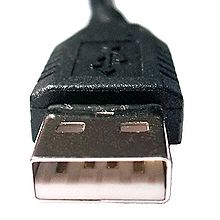Hot swapping
Hot swapping (English for hot swapping ) and hot plugging (English for hot plugging ) denote the changing and exchangeability of system components and modules while the system is running. Hot swapping refers to the replacement of components that do not interact with software. Hot plugging refers to components that interact with software (usually the operating system) and usually require pre-installed software support.
The best-known examples of hot-plug technologies are general computer interfaces such as USB , FireWire , PCMCIA or also Bluetooth for connecting peripheral devices or more specific ones such as the hard disk interfaces SCSI , eSATA and SAS .
Similar to the above, hot swapping also describes the ability to change the program text during runtime without interrupting the execution of the program (see also interpreter ).
variants
- Hot add
- Adding new components.
- Hot plug
- Adding and removing components on the fly as long as the software is not accessing them. Otherwise errors may occur.
- Hot swap
- Replacement of similar or similar components, for example replacing a fan or replacing a hard drive in a RAID .
- Hot switch
- Switching between components, for example to a power supply unit running redundantly as a “hot reserve”.
Typical connector properties
For hot plugging, plug-in contacts must be designed in advance , that is, the contacts are connected and disconnected in a defined sequence, typically in three or more stages. It is easy to implement by means of contacts in a common connector housing, which are set further forwards and backwards in the connection direction. First of all, the connector must have a mechanical guide so that the sequence of steps is stably adhered to. When plugging in first and when removing last, there must be ground contact in order to dissipate ground potential differences or electrostatic charges. Pre-charge contacts are then closed if necessary. Current limiters in these conduction paths protect the contacts themselves as well as the voltage supply of the system from shock loads, for example due to the charging of empty decoupling capacitors . This step takes time. Finally, the operating power contacts and signal lines are connected. The device can now turn on the internal power supply and begin operation. Even if a pre-charge step is provided in the connector, the user should deliberately unplug and, above all, plug in hot-plug plugs as straight and slowly as possible.
- Example USB connector

With USB plugs, both voltage contacts are about 2 mm longer than the data contacts, so that a USB device (e.g. USB mass storage device ) can be switched on before it is actually used and thus damage to the transmission components is prevented.